- Welcome to FictionDB, Guest
- | My Account
- | Help

archyology ii — Don Marquis
buy the book from amazon
Paperback editions:
Hardcover editions:
eBook editions:
Audio editions:
Large Print editions:
Browse Similar Books at Amazon
Literature & Fiction->United States->Classics
Description
Ungrammatical as they may be, archy's wry insights are a true delight, for, as he puts it, “one advantage of being a cockroach is that i see things from the under side.” From that unique perspective we follow the continuing saga of archy, the Cockroach Detective, a spoof on the gumshoe genre in which the six-legged private eye encounters a raja, his chorus-girl harem, Bolshevist twins, an Egyptologist, seven sister manicurists, and a set of bejeweled false teeth. In other episodes archy saves the US fleet from a German U-boat attack, muses with a spider about humanity's inhumanity to insects, stows away on a freighter to London, and climbs to the top of the Washington Monument.
In the Capitol building itself, archy says, “there is no attention paid to me because there are so many other insects around it gives you a great idea of the american people when you see some of the things they elect.” The Ku Klux Klan, he observes elsewhere, “is going strong and the national emblem will soon be the great american kleagle.” Meanwhile, mehitabel, who claims to be a reincarnation of Cleopatra, offers to hire hit-cats to clean up City Hall, not of rats but of reporters. Accompanied by the inspired drawings of cartoonist Ed Frascino, these new archy tales are, Adams writes, “classic American humor, as vivid and amusing today as they were decades ago.”
CERTAIN CONTENT THAT APPEARS ON THIS PAGE COMES FROM AMAZON. THIS CONTENT IS PROVIDED ‘AS IS’ AND IS SUBJECT TO CHANGE OR REMOVAL AT ANY TIME.

 Amazon UK
Amazon UK